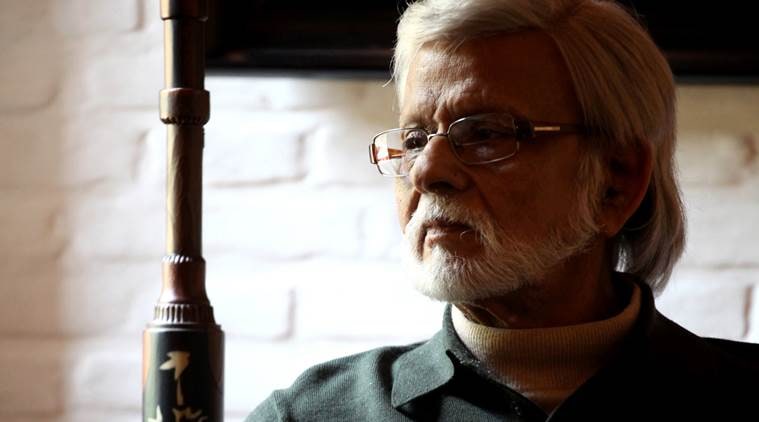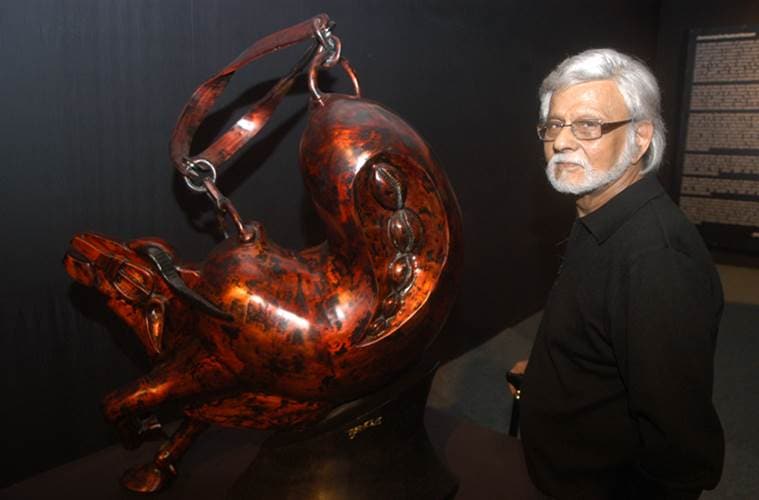 Gujral at his residence in Lajpat Nagar in Delhi. (Express photo by Oinam Anand)
Gujral at his residence in Lajpat Nagar in Delhi. (Express photo by Oinam Anand)
My association with Satish (Gujral) goes back many, many years. I was still working in Grindlays bank (in the 50s) when during one of my visits to Delhi I met Satish. I would say that was the beginning. At that time, he was possibly the first person who was doing large works on buildings; I still remember one at the Oberoi Hotel in Delhi, which occupied an entire wall. It was nice to see that he was not confining himself to small or living room paintings.
Over the years, we became very close friends. It was strange that other members of the Progressive Artists’ Group, like Raza and so on, didn’t know him that well, but artists are still a friendly lot among themselves even if they are not great friends. The reasons could be several, one of which probably was that Satish couldn’t hear properly and most artists like Gaitonde, Tyeb Mehta and Raza couldn’t have lengthy conversations, using gestures, with him. I got through to him more clearly also because I spoke in Punjabi, modulating my face and lips. He understood what I was saying. There is an intimacy to the language if you speak in it all the time and that is also what made me and Satish close. When other artists would talk to him, his wife would have to interpret it for him. Both of us also experienced the Partition and knew how it teared up Punjab. Twenty-two years of my life were spent in Punjab, and you can’t say now move to Delhi and it is the same thing; it is not the same thing. He was probably the first person after the Partition to have painted the sorrow of it, with women crying and so on. His work stands out very much as somebody who was hurt. We were all refugees in a sense, and each one of us did our bit. I did mine and he did his.
 ‘He didn’t confine himself just to painting, he did many things, among which was fantastic architecture.’
‘He didn’t confine himself just to painting, he did many things, among which was fantastic architecture.’
He has left behind a huge legacy. He learnt a great deal from the Mexican muralists, including in terms of material, and came back to India to do his own thing. Formality in painting was very important to him and he maintained that quality. He did not become sentimental. Certain emotion is captured in his work but he doesn’t cry over it. The form speaks for itself, of that particular time and so on. That is a very mature way of handling difficult situations. We even travelled together to Iraq once for an exhibition that had our works. He was a highly cultured person, who was extremely amiable and very well-versed in Urdu poetry.
He didn’t confine himself just to painting, he did many things, among which was fantastic architecture. I saw one house built by him in Golf Links in Delhi, with wonderful spaces that were unimaginable. The sense of space which is called for in a painting is not the same as architecture. When I asked him, how do you switch your concept of space, he said you can also do it, it’s very easy. I knew I couldn’t. He also made wonderful ceramics; he would read books on the medium, temperature guides for certain colours and so on – he was thoroughly into it. I bought some of his ceramics. I also have a painting by him, with Arjun and Krishna on the battlefield. It is difficult to decipher at first, but if you look closely, you can.
We are very grieved that he is gone but it has been one after another — Tyeb, Gaitonde, Bal Chhabra, Raza, Ram Kumar, Akbar; I am left alone.